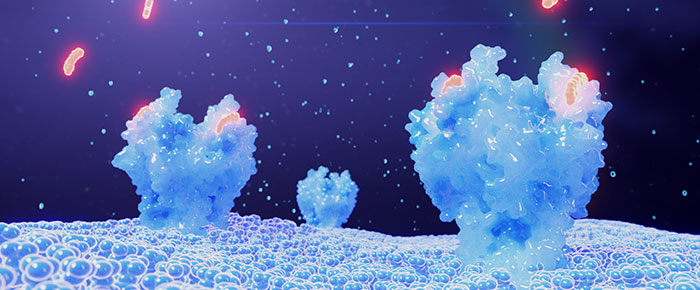 The study of adhesion is essential in the identification industry; this type of research has led to the development of specialized labels that utilize advanced adhesive technology to resist various environmental conditions, from extreme temperatures to chemical exposure. However, adhesion is also important in biological systems. Getting a better understanding of the fundamental mechanisms that govern bioadhesion is of great interest to scientists and can be used to develop new biomaterials, therapies, drug delivery systems, as well as technological applications, such as biosensors.
The study of adhesion is essential in the identification industry; this type of research has led to the development of specialized labels that utilize advanced adhesive technology to resist various environmental conditions, from extreme temperatures to chemical exposure. However, adhesion is also important in biological systems. Getting a better understanding of the fundamental mechanisms that govern bioadhesion is of great interest to scientists and can be used to develop new biomaterials, therapies, drug delivery systems, as well as technological applications, such as biosensors.
What is bioadhesion?
Bioadhesion refers to the phenomenon where two materials, at least one biological in nature, are held together for an extended period of time. It can also refer to the ability of natural and/or synthetic macromolecules to adhere to biological surfaces. While similar and sometimes used interchangeably, mucoadhesion should not be confused with bioadhesion, as it involves the interaction with a mucin surface, including the wetting, adsorption, and interpenetration of polymer chains1.
Conversely, bioadhesives are natural polymeric materials that act as adhesives. The term is also sometimes used to describe synthetic glue formed from biological monomers such as sugars. By incorporating these materials into pharmaceutical formulations, drug absorption can be enhanced, and continual-release drug formulation can be generated. Bioadhesive systems for drug delivery are already being produced for the market that target various tissues, including nasal epithelium and the gastrointestinal tract. In addition, nano-particles coated with bioadhesive polymers have shown some promise during testing, though more research is needed.
Bioadhesive polymers in drug delivery
Polymers can exhibit diverse properties depending on their physical and chemical strength; those possessing hydrophilic functional groups are more favorable candidates for the formulation of targeted drug delivery1. Other properties that may affect the polymer’s mucoadhesive nature include chain length, degree of hydration, degree of cross-linking, and polymer concentration. To date, a large number of bioadhesive polymers have been used to design various formulations, such as tablets, hydrogels, and patches, providing sustained and controlled release. Currently, oral delivery seems to be the most sustainable model for bioadhesive systems, allowing for different types of mucoadhesive dosage forms.
Mucoadhesive drug delivery systems can be evaluated by testing their adhesion strength using various in vitro and in vivo tests1. These include different adhesion measurement techniques (tensile strength, detachment force), x-ray studies to analyze drug transit, and the use of radioactive tracers to determine the activity of a given formulation at the site of interest.
Nano-particle bioadhesive polymers
Bioadhesive nano-particles are a promising new carrier for drug delivery, as they provide prolonged drug retention time at the site of interest and maintain optimal therapeutic concentrations for longer2. In addition, they offer several possible clinical applications, as most polymers used for bioadhesion are both biodegradable and biocompatible. They are able to deliver slow and sustained drug release at the target site through their ability to enhance cargo retention. This is made possible as nano-particle bioadhesives improve their cargo’s interaction with biological systems such as mucus barriers, thereby bypassing the many complex physiological barriers present throughout the gastrointestinal tract that may restrict drug absorption. The use of bioadhesives can also improve drug release for skin or mucous membranes to treat skin diseases such as skin cancer and psoriasis, as well as to help wound healing.
Nano-particle bioadhesives possess the adhesive benefits of typical bioadhesives while also taking advantage of being nanocarriers to assist in drug delivery, making this platform especially suitable for localized therapies2. In addition, they can also be used as coatings to provide adhesive properties to other carriers and improve their biocompatibility. However, long-term safety, behavior, and toxicity concerns remain, requiring further study and testing.
Improved adhesion through ultrasound
To be both effective and safe, medical adhesives must form a tough bond, often in wet and dynamic environments, without using toxic components3. In addition, these adhesives must be biodegradable, as well as easily removable, without causing localized tissue damage. Bioadhesives are ideal for this purpose, though obtaining a solid bond can sometimes prove difficult, especially on wet skin. A group of researchers from McGill University has recently demonstrated that using an ultrasound-mediated strategy can amplify the adhesion energy of these bioadhesives. By altering ultrasonic intensity, they were able to precisely control the stickiness of adhesive bandages on many tissues3. So far, this group has shown that their ultrasound-mediated method works on both rat and porcine skin and significantly increases the adhesion energy of the applied adhesive. Moreover, they were able to detach the adhesive without causing any unwanted tissue damage. As such, this strategy has demonstrated the ability to establish a tough bioadhesion, on-demand detachment, as well as the potential for transdermal drug delivery.
LabTAG by GA International is a leading manufacturer of high-performance specialty labels and a supplier of identification solutions used in research and medical labs as well as healthcare institutions.
References:
- Kumar K, Dhawan N, Sharma H, Vaidya S, Vaidya B. Bioadhesive polymers: novel tool for drug delivery. Artif Cells Nanomed Biotechnol. 2014;42(4):274-83.
- Yu L, Luo Z, Chen T, Ouyang Y, Xiao L, Liang S, Peng Z, Liu Y, Deng Y.Bioadhesive Nano-particles for Local Drug Delivery. Int J Mol Sci. 2022;23(4):2370.
- Zhenwei Ma, Claire Bourquard, Qiman Gao, Shuaibing Jiang, Tristan De Iure-Grimmel, Ran Huo, Xuan Li, Zixin He, Zhen Yang, Galen Yang, Yixiang Wang, Edmond Lam, Zu-Hua Gao, Outi Supponen, Jianyu Li. Controlled tough bioadhesion mediated by ultrasound. Science. 2022;377(6607):751-755.

